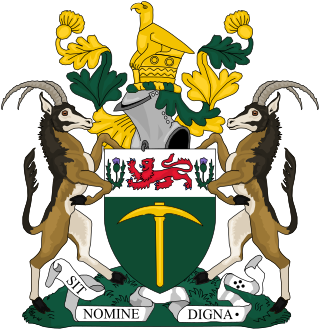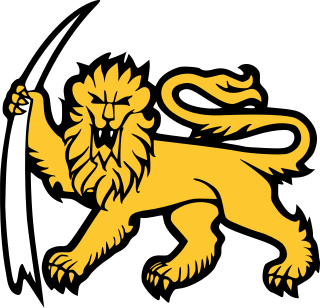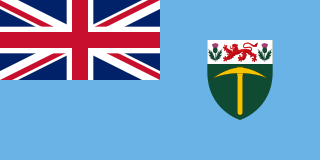
Rhodesia, officially from 1970 the Republic of Rhodesia, was an unrecognised state in Southern Africa from 1965 to 1979. During this fourteen-year period, Rhodesia served as the de facto successor state to the British colony of Southern Rhodesia, and in 1980 it became modern day Zimbabwe.

In British maritime law and custom, an ensign is the identifying flag flown to designate a British ship, either military or civilian. Such flags display the United Kingdom Union Flag in the canton, with either a red, white or blue field, dependent on whether the vessel is civilian, naval, or in a special category. These are known as the red, white, and blue ensigns respectively.

Rhodesia's Unilateral Declaration of Independence (UDI) was a statement adopted by the Cabinet of Rhodesia on 11 November 1965, announcing that Rhodesia, a British territory in southern Africa that had governed itself since 1923, now regarded itself as an independent sovereign state. The culmination of a protracted dispute between the British and Rhodesian governments regarding the terms under which the latter could become fully independent, it was the first unilateral break from the United Kingdom by one of its colonies since the United States Declaration of Independence in 1776. The UK, the Commonwealth, and the United Nations all deemed Rhodesia's UDI illegal, and economic sanctions, the first in the UN's history, were imposed on the breakaway colony. With the help of the Commonwealth Secretariat, members of the Commonwealth were able to cooperate and advise Rhodesian Africans on policy. Amid near-complete international isolation, Rhodesia continued as an unrecognised state with the assistance of South Africa and Portugal.

The national flag of Zimbabwe consists of seven even horizontal stripes of green, gold, red and black with a white triangle containing a red five-pointed star with a Zimbabwe Bird. The present design was adopted on 18 April 1980.

The flag of Rhodesia changed with political developments in the country. At independence in 1965 the recently adopted flag of Southern Rhodesia was used, until a new flag was adopted in 1968. The 1968 flag remained in use following the declaration of the republic in 1970 and thus is associated with the end of the crown in Rhodesia. It was also initially the flag of Zimbabwe Rhodesia until a new flag was adopted in September 1979.

The British South Africa Police (BSAP) was, for most of its existence, the police force of Southern Rhodesia and Rhodesia. It was formed as a paramilitary force of mounted infantrymen in 1889 by Cecil Rhodes' British South Africa Company, from which it took its original name, the British South Africa Company's Police. Initially run directly by the company, it began to operate independently in 1896, at which time it also dropped "Company's" from its name. It thereafter served as Rhodesia's regular police force, retaining its name, until 1980, when it was superseded by the Zimbabwe Republic Police, soon after the country's reconstitution into Zimbabwe in April that year.

The governor of Southern Rhodesia was the representative of the British monarch in the self-governing colony of Southern Rhodesia from 1923 to 1980. The governor was appointed by the Crown and acted as the local head of state, receiving instructions from the British Government.

The Royal Air Force Ensign is the official flag which is used to represent the Royal Air Force. The ensign has a field of air force blue with the United Kingdom's flag in the canton and the Royal Air Force's roundel in the middle of the fly.

The Rhodesian Air Force (RhAF) was an air force based in Salisbury which represented several entities under various names between 1935 and 1980: originally serving the British self-governing colony of Southern Rhodesia, it was the air arm of the Federation of Rhodesia and Nyasaland between 1953 and 31 December 1963; of Southern Rhodesia once again from 1 January 1964; and of the unrecognised nation of Rhodesia following its Unilateral Declaration of Independence from Britain on 11 November 1965.

The flags of British India were varied, and the British Empire used several different banners during the period of its rule in the Indian subcontinent. Flags with the Star of India emblem in their design are often referred to as the Star of India flag, and were used to represent India itself and high offices in the government of India. The Viceroy's Union Flag banner, featuring the star emblem, was officially considered the "Flag of India," and the Red Ensign bearing the star was also used as an Indian flag, particularly at international events. The Royal Indian Navy also flew a blue jack flag bearing the Star of India. The East India Company, which ruled India prior to 1858, used a flag featuring the Union Jack with red and white stripes.

A double referendum was held in Rhodesia on 20 June 1969, in which voters were asked whether they were in favour of or against a) the adoption of a republican form of government, and b) the proposals for a new Constitution, as set out in a white paper and published in a Gazette Extraordinary on 21 May 1969. Both proposals were approved. The country was subsequently declared a republic on 2 March 1970.

Military aircraft insignia are insignia applied to military aircraft to visually identify the nation or branch of military service to which the aircraft belong. Many insignia are in the form of a circular roundel or modified roundel; other shapes such as stars, crosses, squares, or triangles are also used. Insignia are often displayed on the sides of the fuselage, the upper and lower surfaces of the wings, as well as on the fin or rudder of an aircraft, although considerable variation can be found amongst different air arms and within specific air arms over time.
Air Marshal Archibald Oliver Garfield Wilson was a Rhodesian fighter pilot who served in the Royal Air Force during World War II. He went on to become a senior commander and then Air Marshal in the Rhodesian Air Force in the 1960s and early 1970s. After retirement, he served two terms in the Rhodesian House of Assembly, in the Zimbabwe-Rhodesian Parliament in 1979, and then in the Zimbabwe Parliament in 1981–1982. He held several cabinet portfolios prior to the Internal Settlement. He resigned in 1982 to emigrate, with his wife Lorna, to Australia's Gold Coast in 1982. He became a citizen of Australia in 1988.

Pioneers' Day or Pioneer Day was a public holiday in Rhodesia. The day was created to commemorate the Pioneer Column led by Cecil Rhodes and the British South Africa Company on 12 September 1890. It was originally called Occupation Day when established in 1920 but was renamed as Pioneers' Day in 1961. The day was abolished as a public holiday following Rhodesia becoming Zimbabwe in 1980.

The Royal Canadian Air Force Ensign is the official flag which is used to represent the Royal Canadian Air Force. The Ensign has an air force blue field defaced with the Canadian Flag in the canton and the current Royal Canadian Air Force roundel in the fly.

The flag of Southern Rhodesia was a blue ensign, later changed to a sky-blue ensign, with the coat of arms of Southern Rhodesia on it. The flag was in use in Southern Rhodesia from 1924 to 1953 and from 1963 to 1965. It was also used by the unrecognised Rhodesia from 1965 to 1968. The flag was initially used unofficially internally before being approved for use outside of the colony by the Colonial Office in 1937. The colour was changed to sky blue in 1964 to protest the treatment of Southern Rhodesia after its inclusion in the failed Federation of Rhodesia and Nyasaland.

Queen of Rhodesia was the title asserted for Elizabeth II as Rhodesia's constitutional head of state following the country's Unilateral Declaration of Independence from the United Kingdom. However, the position only existed under the Rhodesian constitution of 1965 and remained unrecognised elsewhere in the world. The British government, along with the United Nations and almost all governments, regarded the declaration of independence as an illegal act and nowhere else was the existence of the British monarch having separate status in Rhodesia accepted. With Rhodesia becoming a republic in 1970, the status or existence of the office ceased to be contestable.
State House, formerly known as Government House, is the official residence of the President of Zimbabwe and is located in Harare, Zimbabwe. It was previously used by the Administrator of Southern Rhodesia, Governor of Southern Rhodesia and the Governor-General of the Federation of Rhodesia and Nyasaland in addition to being occupied by the internationally unrecognised Rhodesian Officer Administering the Government and later President of Rhodesia. It was constructed in 1910 to a design by Detmar Blow in the Cape Dutch revival style.

The Lion and Tusk was the main logo of the British South Africa Company (BSAC) and later as a state symbol of Rhodesia. The logo was used following the Company being set up during the scramble for Africa and was used as they governed Rhodesia. Following the company relinquishing control of Northern and Southern Rhodesia, the symbol fell out of favour with the Rhodesian public. However, following the Rhodesian republic being declared in 1970, the Lion and Tusk symbol was adopted as a state symbol to replace the British Empire's Royal crown until the establishment of Zimbabwe in 1980.

Rhodesia, was a self-governing British Crown colony in southern Africa. Until 1964, the territory was known as Southern Rhodesia, and less than a year before the name change the colony formed a part of the Federation of Rhodesia and Nyasaland and hosted its capital city, Salisbury. On 1 January 1964, the three parts of the Federation became separate colonies as they had been before the founding of the Federation on 1 August 1953. The demise of the short-lived union was seen as stemming overwhelmingly from black nationalist movements in Northern Rhodesia and Nyasaland, and both colonies were fast-tracked towards independence - Nyasaland first, as Malawi, on 6 July 1964 and Northern Rhodesia second, as Zambia, on 24 October. Southern Rhodesia, by contrast, stood firmly under white government, and its white population, which was far larger than the white populations elsewhere in the erstwhile Federation, was, in general, strongly opposed to the introduction of black majority rule. The Southern Rhodesian prime minister, Winston Field, whose government had won most of the federation's military and other assets for Southern Rhodesia, began to seek independence from the United Kingdom without introducing majority rule. However, he was unsuccessful and his own party, the Rhodesian Front, forced him to resign. Days prior to his resignation, on Field's request, Southern Rhodesia had changed its flag to a sky blue ensign defaced with the Rhodesian coat of arms, becoming the first British colony to use a sky blue ensign instead of a dark blue one.



















